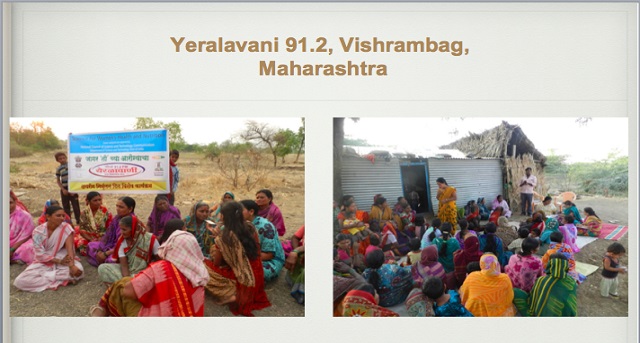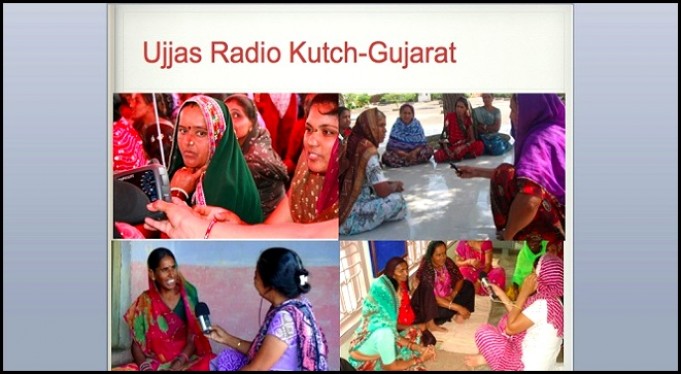Community Radio: here is the community!
This article is in response to the article published in the Hoot: 'Community radio—where is the community'?
There are 196 CR stations in India which are supposed to be functional according to the Ministry of Information and Broadcasting website. It is common knowledge and a fact known to CR activists and unofficially to the Government officials that at least 30 stations are not operational or not broadcasting regularly. Out of 160 and odd CR stations which are broadcasting regularly, some operate 22 hours a day and some only one hour for three days in a week. This itself shows the amount of flexibility and variety the CR stations operators enjoy.
The published article done out of a UNDP grant, takes 10% of CR stations and claims to be randomly selected for the study. As a Community Radio Practitioner, one found that the sample was not selected on scientifically random basis but it was a purposive sample with the sole intention of bringing negativity to the CR movement in the country. The authors have a preconceived notion and the results are not based on facts but on flawed philosophy. While doing so, the authors should have taken into account the non-operational CR stations and replace them with some others. Also it appears while talking about religion only the Hindu religion is being targeted while it is common knowledge that many CR stations are run by Christian institutions and there are CR stations in a Mosque compound.

This writer’s intention is not to counter point by point of the referred article but to give some stronger and lesser known facts about the ownership of CR stations in the country and also highlight the empowerment of women by CR stations in many parts of India. There are many PhD thesis supporting this contention, from Tamilnadu to UP and Delhi. ( Neeraja Prabhakar, Anna university, Abhilaksh Likhi, Jamia Milia Islamia, Ujjwlala Tirkey, Apeejay Stya university ( under submission).
Absolute community ownership of a radio stations is an ideal, and something one would wish for. I am afraid that nowhere in the world you can pinpoint one such station. At the most you can highlight some of the community mobilisation efforts and interactions on matters of public interest. A Radio stations has to be owned by a legal entity as long as licensing system exists. India’s community Radio policy is one of the best in the world which allows allotment of free frequencies for educational, agricultural and civil society organisations. Even though some may argue that all the three sector need separate guidelines, as long as there is no scarcity of frequencies, there is no immediate cause for alarm.
By the time that situation emerges, India would have gone for digital frequencies and the problem of scarcity would have become one of abundant availability. Hence we must talk only of community ownership of the contents . While UNESCO claims that its CR initiatives are to be taken as Bible, it’s model is being broken in the very face of UNESCO chair in UOH Hyderabad. The Radio station BOL Hyderabad, leave alone community ownership, does not even have a community member in its management committee. (Source: CR compendium) It is only preaching to the world and not for themselves. They might argue that it is a campus radio but there is no such legal entity called ‘campus radio’ and all CR stations have signed an agreement called GOPA which states that ‘at least 50% of the programmes ‘ are to be produced by the community.
The National Council for Science and Technology Communication has silently been engaging nationwide CR stations from the year 2005 and now has interacted with 66 CR stations through their ‘Science for Women’s Health and Nutrition’ initiative and Radio Mathematics programmes. Presently the programme is in the final phase at 9 CR stations, in the middle phase at 5 CR stations and14 stations are in the preliminary phase of this nationwide project.

In the case of Science for women’s health and nutrition projects, the first 1000 women in the listening zone of the CR station are surveyed regarding their media habits, their health needs (which might differ from the available government records) and the media gap. The survey is done by the community women themselves. After that analysis is made and a local advisory committee with local doctors, nutritionists and community women (one a teenager and another middle aged) discusses the survey results. They come out with a road map for their area. Around 10 women per station are selected to undergo further training in broadcast techniques, scripting, and presentation. They produce the year-long programme which is funded adequately. 4000 rupees per programme per day per station is the financial support. Once a month the station organises an event in the listening zone of the station , such as health camps, cancer detection, TB and HIV awareness, nutrition camps, cookery competitions and so on. A large number of women participate. At the end of the year the stations do succeed in empowering a few women at the grassroots to becoming communicators and radio broadcasters.
This writer can quote a few names of such empowered women,— Vandana Kote from Baramati who had later successfully contested the local body elections, Geetha Lakshmi from Tiruchirappalli who later became a station manager of a CR station, Jameela from Chennai, wife of an auto rickshaw driver who is now DST’s content creation expert for another CR station, Dhanam from Madurai who has graduated from a ‘Ayah’ of a primary school to a broadcaster, Priyanka a transgender from Radio Active Bengaluru and women from SEWA Gujarat, Barefoot college, Tilonia and others. But unfortunately there is no mention about these initiatives in the mainstream media.

There is data of about 40000 women available and all of them will be ‘online’ soon. Presently all the reports are available with the Department of Science and Technology. These programmes are owned 100% by the community. This writer urges that readers contact Vidya Prathistan Baramati, SEWA Ahmedabad, Radio Siwan, Voice of Azamgarh, Alfaz e Mewat, Radio Mewat, Deccan Radio, Hyderabad, Yeralavani, Sangli, and Vayalagam Vanoli, Kottampatti, Tamilnadu and see for themselves the extent of community management of programmes .
Another such initiative is functional--Radio Mathematics. The first phase of 10 radio stations was completed a year back and another set of 12 stations have already been informed about their selection in the programme. The mathematics that is broadcast is functional in nature , through music, folk arts, drama, and makes mathematics fun. It was assessed by an independent assessor, Media Research Forum of Madurai with Prof Shanta, Rtd. Professor of Science Journalism of MKU . She had rated the stations on the basis of its outcome and other parameters. Jandwani from Mysore came first among the 10, followed by Vidya Prathistan, Baramati and Radio Active Bengaluru. Alwar Ki Awaz, Kumaon Vani, Periyar CR Thanjavuru and MUST radio Mumbai followed them. A copy of the interim report can also be made available by its author Dr Shantha Arunachalam.
While a lot more needs to be done in the CR sector, activism alone is not going to solve the problem. If a few individuals who claim to be CR trainers instead of relying on dollars and foreign funding, go to the field and work among the grassroots, they will do more service to the sector. The author does not want to give details of foreign funding, the money received by the activists, and cases of ditching the society when their funding dried. Some stations do need mention such as Chanderi ki Awazz, Henvelvani, and Mandakini Awaaz where the community had to raise for themselves the money to create their station since foreign funding had stopped and the consultants ran away. Also the fact that supply of free transmitters by UNESCO to more than 2 dozen radio stations and their maintenance and repair became a nightmare for the CR stations need to be highlighted .
A few individuals who regularly get foreign funding in the name of CR for the past two decades, have done much damage to the sector. But they have amazing skills in project writing, presentation. They have many friends and students in main stream newspapers and TV channels. Their only aim is to defame the existing CR stations and go on demanding more and more liberalization of the policy than to help the present CR stations in marching towards sustainability.
To conclude, I would like to highlight that more than 50% of CR stations in the country are working towards management of contents by the community and the main villain for the sector’s non development in fast pace is the WPC (Wireless Planning and Coordination) wing of the Telecommunications Ministry. It is like a dog’s tail which no one can straighten.
An analysis of the time taken by WPC wing for the past 10 years show that the limit of 90 days as stipulated in the Policy guidelines was broken in 90% of the cases. With the exception of stations like Delhi University no one else has got the frequency allocation, SACFA (Standing committee on Frequency allocation) clearance and wireless operating licenses during the stipulated period. This in spite of the fact that the Ministry of Information and Broadcasting before it issues a Letter of Intent, ensures that the applicant institution will be allotted the necessary frequency from WPC at the location cited by it.
Dr Sreedher Ramamurthy launching India’s first licensed Community Radio Station at the Anna University Campus in 2004. He has been associated with a large number of CR stations, and set up the earliest educational TV channels in the country.







